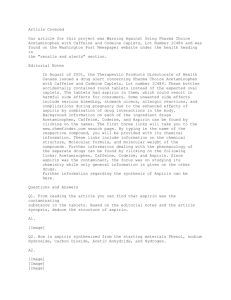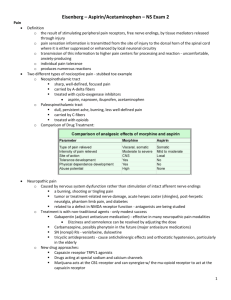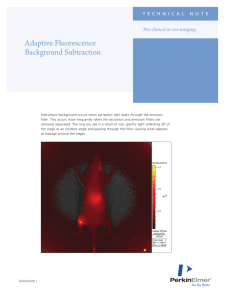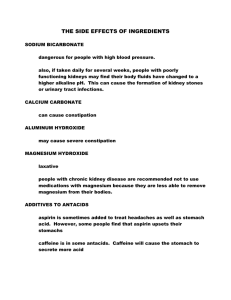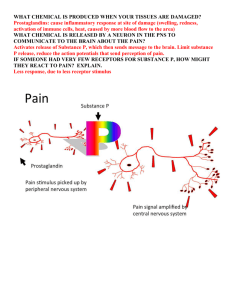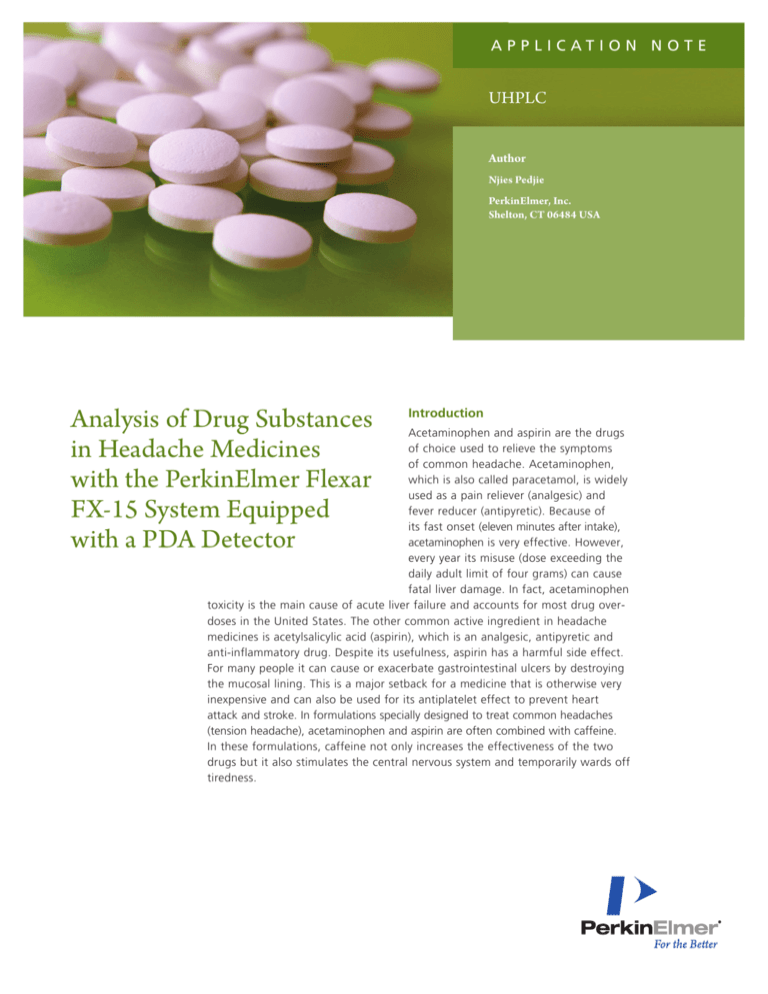
a p p l i c at i o n N o t e
UHPLC
Author
Njies Pedjie
PerkinElmer, Inc.
Shelton, CT 06484 USA
Analysis of Drug Substances
in Headache Medicines
with the PerkinElmer Flexar
FX-15 System Equipped
with a PDA Detector
Introduction
Acetaminophen and aspirin are the drugs
of choice used to relieve the symptoms
of common headache. Acetaminophen,
which is also called paracetamol, is widely
used as a pain reliever (analgesic) and
fever reducer (antipyretic). Because of
its fast onset (eleven minutes after intake),
acetaminophen is very effective. However,
every year its misuse (dose exceeding the
daily adult limit of four grams) can cause
fatal liver damage. In fact, acetaminophen
toxicity is the main cause of acute liver failure and accounts for most drug overdoses in the United States. The other common active ingredient in headache
medicines is acetylsalicylic acid (aspirin), which is an analgesic, antipyretic and
anti-inflammatory drug. Despite its usefulness, aspirin has a harmful side effect.
For many people it can cause or exacerbate gastrointestinal ulcers by destroying
the mucosal lining. This is a major setback for a medicine that is otherwise very
inexpensive and can also be used for its antiplatelet effect to prevent heart
attack and stroke. In formulations specially designed to treat common headaches
(tension headache), acetaminophen and aspirin are often combined with caffeine.
In these formulations, caffeine not only increases the effectiveness of the two
drugs but it also stimulates the central nervous system and temporarily wards off
tiredness.
The hepatotoxicity of acetaminophen combined with the
risk of stomach bleeding linked to aspirin are serious health
problems that can be prevented by accurate label claims and
proper medical indications. That is why in the pharmaceutical
industry, routine assay testing to ensure the accuracy of the
amount of active ingredients is a standard procedure and
also a part of the Food and Drug Administration requirements.
This application note presents a modified USP method
for the analysis of aspirin, acetaminophen and caffeine
(Figure 1) using a superficially porous particle column and
a PerkinElmer® UHPLC platform. The changes to the USP
method are intended to increase the throughput and reduce
the solvent consumption. Method conditions and performance
are presented. Two headache medicines, one brand name
and one generic are tested and the amount of the active
ingredients determined.
A PerkinElmer Flexar™ FX-15 UHPLC system fitted with a
Flexar FX PDA photodiode array detector was the platform
for this experiment. The separation was achieved using a
PerkinElmer Brownlee SPP C-18, 2.7 µm, 100 x 2.1 mm
column. The run time was 4.4 minutes with a back pressure
of 4000 PSI (276 bar).
Table 1. Detailed UHPLC system and chromatographic
conditions.
Autosampler: Flexar™ FX UHPLC
Setting:
50 µL Loop and 15 µL needle volume, partial
loop mode
350 µL mixer volume
Injection: 10 µ, 2 µL; injector wash: water
HPLC Column:
PerkinElmer Brownlee Analytical C18,
100 x 4.6 mm, 5 µm
Part No. N9303512 at 45 °C
Mobile Phase:
B: 69:28:3 water/methanol/acetic acid
1.0 mL/min, 12 min.
UHPLC Column: PerkinElmer Brownlee SPP C18,
100 x 2.1 mm, 2.7 µm
Acetaminophen
Aspirin
Caffeine
Figure 1. Molecular structure of drug substances analyzed.
Experimental
A stock standard with 0.25 mg/mL of acetaminophen and
aspirin and 0.065 mg/mL of caffeine were prepared by
dilution of net weight with mobile phase, a one min.
vortexing was followed by two to three min. sonication.
For the working standard, 4.0 mL of the stock solution and
0.3 mL of internal standard (6 mg/mL of benzoic acid in
methanol) were transferred into a 10 mL volumetric flask
and brought to volume with mobile phase to obtain a solution
of 0.1 mg/mL of acetaminophen and aspirin, 0.026 mg/mL
of caffeine and 0.18 mg/mL of internal standard. Repeatability was evaluated with seven injections of the working
standard. Linearity was determined across the range of
0.1 µg/mL to 100.0 µg/mL. Tablets from a brand name form
of the drug, and capsules from a generic form of the drug,
both with labeled amount of 250/250/65 mg (acetaminophen/
aspirin/caffeine), were prepared by transferring a net weight
equivalent to a tablet or capsule into individual 100 mL
volumetric flask. Both of the preparations were diluted with
mobile phase, followed by a minute vortexing and 15 min.
of sonication. 2.0 mL of each preceding solution and 1.5 mL
of internal standard were transferred into separated 50 mL
volumetric flasks and brought to volume with mobile phase.
Samples were thoroughly mixed and filtered through a
0.2 µm nylon membrane prior to testing.
2
Part No. N9308404 at 55 °C
Mobile Phase:
B: 69:28:3 water/methanol/acetic acid
0.25 mL/min, 4.4 min.
PDA Detector:
Scanned from 190 – 700 nm, recording
setting 275 nm
Alternate setting to 275 nm: Optimized
wavelengths
Time (min.) Wavelength (nm)
0-1.3245
1.3-2.5275
2.5-4.4232
Software:Chromera® Version 3.0
Sampling Rate:
5 pts/sec
Results and Discussion
Initially, the USP method was implemented as it is with a
conventional C18, 100 x 4.6 mm, 5 µm particle size HPLC
column with 1.0 mL/min flow rate and 45 °C; all the peaks
eluted within 12 minutes (Figure 2). By using a shorter
column with smaller particle size (PerkinElmer Brownlee
SPP C18 100 x 2.1 mm, 2.7 µm) at 55 °C, and by using the
mobile phase as diluent instead of the mixture of methanol
and glacial acetic acid (95:5) called for by the USP method,
the pressure stabilized at about 4000 PSI and the run time
was dramatically reduced from 12 minutes to 4.4 minutes.
Moreover, the resolution and sensitivity were significantly
improved (Figure 3). Prior to running the sample, from one
injection of the standard, the maximum wavelength for each
peak was determined and the wavelength recording setting
Absorbance (mAU)
In addition to about a threefold reduction in chromatographic
run time, the flow rate was reduced to 0.25 mL/min. from
1.0 mL/min. Thus, 63% reduction in testing time and 90%
reduction in solvent usage was achieved by moving to a
UHPLC method, resulting in far less solvent disposed of
as dangerous waste. Overall, by moving a traditional HPLC
method to a UHPLC method, the cost of labor and chemicals
are significantly reduced, providing for a greener laboratory
operation.
Acetaminophen
Absorbance (mAU)
was optimized, resulting in the improvement of the UV
absorbance up to fivefold (see Figures 4 and 5). From the
standard solution chromatogram, a spectral library was
created (Figure 6), and was later used for peak identification
confirmation in the samples (Figures 7 and 8).
Benzoic acid
600
400
Aspirin
200
Caffeine
0
0
1
2
3
Time (min)
4
Figure 5. Chromatogram from the analysis of the standards with wavelengths
setting optimized.
Acetaminophen
80
60
Caffeine
40
Benzoic acid
Aspirin
20
0
0
2
4
6
8
Time (min)
10
12
Figure 6. UV Spectra from the standard solution run.
Acetaminophen
150
Caffeine
100
Benzoic acid
Aspirin
50
0
0
1
2
3
Time (min)
4
Figure 3. Chromatogram from the analysis of the standards using a superficially
porous particle C18 column.
Absorbance (mAU)
Absorbance (mAU)
Figure 2. Chromatogram from the analysis of the standards using a conventional
C18 column.
Acetaminophen
150
Caffeine
100
Benzoic acid
Aspirin
50
0
0
1
2
3
Time (min)
4
Figure 7. Peaks of drug substances in a generic headache medicine.
Figure 4. Chromatogram from the analysis of the standards showing the
maximum absorbance for each peak.
3
Conclusion
Figure 8. Peak identification of a generic headache medicine using the spectral
library.
Excellent method performance was achieved. The linearity
of the analysis shows R-squared values of 0.9999 or 1 and
precisions values ranging from 0.58% to 0.98% RSD. Details
of the method performance and results of the samples tested
are presented in Table 2.
Table 2. Precision, linearity and amount in samples.
%RSD Linearity Range
Brand
(n=7) r² (µg/mL)Generic name
Acetaminophen0.76
1
0.60-100 100.5% 96.9%
Caffeine
0.58
1
0.16-26 98.2%97.6%
Aspirin
0.98
Average
0.77 1
0.9999 1.25 -100
93.3%
93.8%
NA 97.396.1
NA = not applicable
The application of UHPLC to the analysis of acetaminophen,
aspirin and caffeine in headache medicine resulted in a
63% reduction in run time, as well as a 90% reduction in
solvent usage. The PerkinElmer Flexar FX-15 UHPLC system
and PerkinElmer Brownlee SPP C-18, 2.7 µm, 100 x 2.1 mm
resolved all three drug substances. The method was shown
to be linear with R-squared ≥ 0.9999 and precise with %RSD
≤ 0.98. The brand name drug product has 243/235/64 mg
per tablet of acetaminophen/aspirin/caffeine, and the generic
form of the drug has 275/233/64 mg; these are both well
within the limit of not less than 90.0% and not more than
110.0% of the labeled amounts as specified in the USP
monogram. The Chromera software offers many data
acquisition and processing features, including spectral
library creation, absorbance maximum for each peak, which
are powerful tools for interrogating the information content
of a 3D photodiode array chromatogram. The spectral library
creation and search function allowed the storage of standard
peaks spectra that were later used for peak identification
confirmation in the samples.
References
1.Larson, A.M., Polson, J., Fontana, R.J., et al, December
2005. “Acetaminophen-induced acute liver failure:
results of a United States multicenter, prospective study.”
Hepatology 42 (6): 1364–72.
2.USP 34. Official USP Monogram; Acetaminophen, Aspirin,
and Caffeine Tablets; May 1, 2011, pages 1725, 1726.
3.Drugs.com prescription drug information and side effects.
Retrieved August 12, 2011.
4.National Center for Biotechnology Information (NCBI),
PubMed Health http://www.ncbi.nlm.nih.gov/
pubmedhealth/PMH0000521/
5.U.S. Preventive Services Task Force; “Aspirin for the
Prevention of Cardiovascular Disease: U.S. Preventive
Services Task Force Recommendation Statement;” Annals
of Internal Medicine; March 17, 2011.
Note: This application note can be changed without prior
notice.
PerkinElmer, Inc.
940 Winter Street
Waltham, MA 02451 USA
P: (800) 762-4000 or
(+1) 203-925-4602
www.perkinelmer.com
For a complete listing of our global offices, visit www.perkinelmer.com/ContactUs
Copyright ©2011, PerkinElmer, Inc. All rights reserved. PerkinElmer® is a registered trademark of PerkinElmer, Inc. All other trademarks are the property of their respective owners.
009882_01

